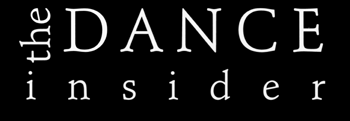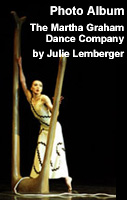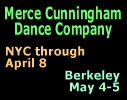|
Brought to
you by

the New
York manufacturer of fine dance apparel for women and girls. Click
here to see a sample of our products and a list of web sites
for purchasing.
With Body Wrappers it's always performance
at its best.
Go back to Flash Reviews
Go
Home
Flash Review, 4-5: Change Direction
New Tricks from an Old Master
By Paul Ben-Itzak
Copyright 2001 The Dance Insider
My friend Romy tells the following
apocryphal story. She was interning one summer with the American Dance Festival
in NYC, and was assigned to drive Merce Cunningham and John Cage to an event.
Merce knew how to get there, she didn't. They stopped at a red light somewhere
in midtown, and Romy heard Merce quietly direct her from the back seat: "Change
Direction." I recalled this story last night at City Center's Merce Cunningham
Dance Company concert, after watching Cunningham's 1958 "Summerspace," and the
much newer 1999 "Biped," in which Land of the Giants virtual dancers loom in front
and above of real dancers. Or maybe it's relatively tadpole-sized real dancers
swimming about, "Fantastic Voyage"-like, inside large virtual dancers. In any
case, it was an experiment that didn't quite work for me, even if it had most
of the audience en thrall. But I still left the theater preferring watching Merce's
experiments to the regurgitations some other veteran choreographers such as Paul
Taylor try to pass off as new work.
One snowy October morning, a young
man just starting at Princeton walked from the Village digs of his sophisticated
cousin all the way up Fifth Avenue to Rockefeller Center. His cousin thought he
was crazy, but this was not only the first snow of the season, but the first live
snow this California boy had ever experienced. He wanted to taste the flakes on
his tongue, and marvel at the pretty girls and soaring buildings on The Avenue.
From turning his head to look at the women, and stretching it back to look at
the skyscrapers, he finna got whiplash. It took him another 15 years to move to
New York, and when he did, he found a cozy nook right off The Avenue. Every day
he walked the 50-plus blocks from his apartment on 8th Street to Columbus Circle,
near Central Park. Pretty soon it became routine to him, and he no longer looked
anywhere but straight ahead.
Then he visited a foreign city --
Paris -- to which he'd never been before. He was lost. He was exhilarated. The
more he got lost -- the more he changed directions -- the more he saw, the more
he discovered. He hadn't felt this alive in a long time. Time seemed to slow down.
He decided he'd move to Paris in a New York minute. But he also determined that
before he did, he'd change directions more often in New York.
Okay, the man was me! So, er, getting
to last night and almost to the curtain -- hang in there, Dance Insider! -- last
night I decided to walk up First Avenue from downtown to City Center, on 55th.
Wow! First, you can see the East River at your, er, east. At sunset into twilight,
the azure sky and the turquoise water inspire about as much serenity as you're
likely to be able to find in New York City. You get to the 40s and start to see
the UN. Turn west into Ralph Bunche plaza, up some stairs, over Yitzak Rabin way,
down UN Way, and the Chrysler Building looms, and beyond it Grand Central Station.
Look up, and on the newly restored ceiling you see the constellations! Right down
to faux twinkling stars. It's the grandest parlor you've ever walked through.
Not as many glistening women on this
route as the path up The Avenue. Not as many glistening skyscrapers. A little
more rough and rugged. And yet I felt more alive, more attuned to my environment
than I've felt for a long time on Fifth Avenue -- because of the newness.
Creation should be, most of all,
about newness. What I and many people love about Merce Cunningham is that it's
more important to him to be constantly inventing a new language than to hug familiar
shores, if I can mix my metaphors. I see dozens of post-mod concerts, ballet concerts,
and, yes, concerts in the Pilobolus-Momix mode, in which what's being done isn't
always new. Crowd-pleasers, certainly. Honest efforts, most of the time. (I suspect
more than a bit of cynicism in the way Taylor -- whose dark ballets continue to
disturb, and that's a compliment -- has turned out the same froth in his lighter
ballets for the past few years, at least the ones I've seen.) But if I see one
more brochure that describes as daring a work whose outline I could predict before
seeing it, I'm going to storm the stage and start standing around in my own underwear!
(Elizabeth Zimmer of the Village Voice, positively reviewing Karim Noack's "Six
Months to Live," which takes its plot from Noack's fight against cancer, offers
this delicious morsel this week on the La MaMa show: "Arlene Croce would probably
hate it. You could, I suppose, call it 'victim art,' and it's certainly agitprop,
but it's a hell of a lot more effective and moving than much of the rinsed contemporary
work to which I am endlessly subjected.") David Parsons's "Pied Piper" coming
up on American Ballet Theatre might actually turn out to take some risks -- Parsons
has a way of surprising in his darker works. But the premieres by Paul Taylor
and Mark Morris? Proficient, certainly. Entertaining to many? Probably. But a
daring programming choice? You want to give me a daring new direction, ABT, turn
Bill T. Jones loose on those dancers. Or Mark Dendy. Let me see what Jowole Willa
Jo Zollar could do with them, or Pina Bausch.
All of this is to say that what I
love about Merce Cunningham is his sheer unpredictability. This is an artist who,
at 81, would certainly be forgiven some repetition. But his choreographic raison
d'etre is surprise. Usually it's surprise on the micro level -- how a body moves
or intersects with other bodies. The group patterns. Sometimes, as with "Biped,"
in which sort-of-holographic figures created by Shelley Eshkar and Paul Kaiser,
using the dancers as sensor-models, along with other particles -- splinters, ping-pong
balls, vertical bars -- refract off a transparent scrim, making them seem to inhabit
the whole stage like a forest of light trees and ghosts, the change is in the
direction of the production.
Now that I've established my esteem
for Merce's unrivaled leadership role as an experimentalist, I gotta tell you
that this particular experiment left me somewhat cold. Eshkar-Kaiser's apparitions,
mesmerizing at first, soon become repetitive. I found myself yawning. (Although
the long walk might have played a part there!) And yet, paradoxically, even as
we know their movements are not one-hundredth as interesting as those being performed
by the human dancers, because of the virtual dancers' novelty, because they're
in front of and bigger than the live dancers and thus seem to dwarf them, and
maybe also just because they're made of light, and we're drawn to light -- they
have the effect of diminishing the live dancers and making it hard to focus on
their movement. The virtual creatures certainly aren't constant, so I was able
to glean that the movement on the live dancers is some of the most varied I've
seen in the handful of Merce works I've observed. We get solitary dancing, small
groups, large groups. Limited partnering, more vigorous partnering, right up to
tossing. Quick changes of pace. Contributing to the diminishment of the dancers,
I think, is that, as my non-dancer companion observed, the real and virtual dancers
never interact. Indeed the most poignant moments come when Robert Swinston looks
up as if he senses this larger force hovering (or is it that these real bipeds
are actually living inside these larger beings, exploring them as in the film
"Fantastic Voyage"?); and when Lisa Boudreau and Daniel Squire, towards the dance's
climax -- and yes, it does have a climax, as I said, Merce always surprises --
step farther downstage than anyone before, with Boudreau even kneeling, and seem
to reach out to touch the scrim, as if they've finally realized they are not alone.
("I believe!")
It's kind of the nightmare I referred
to in yesterday's Merce review, in that case a post-apocalyptic
scene from a Donald McKayle ballet: As if the pre-historic creatures just bubbled
up from the ocean in "Pond Way" have now been catapulted, Howard the Duck like,
into a world they never made and maybe aren't even aware exists beyond/above/over/around
them. I'm not sure whether they were at peace with it, I just know that I wasn't.
I think perhaps it's also that Merce's work is already so high-tech, that seeing
it on live dancers gives it a humanity that I at least crave in a dance performance;
seeing it on virtual dancers, and in a much more limited choreographic scope,
is a little too scientific for me.
"Summerspace," by contrast, finds
our Cunninghamian heroes a bit closer to the age of innocence. I'll refer you
to my colleague Alicia Mosier's earlier Flash for the
overall contours of the ballet. Since last night's cast was different, I do want
to report on them. The last time I saw this ballet was on the dancers of New York
City Ballet, who did well by it. What's different here is where the NYCB dancers
evoked birds, their protean modern equals were, well, as my companion said, amoebae.
Not just in the ways they individually moved, but the ways they would suddenly,
erratically, jut off in one direction, intersect each other, disappear, or re-appear:
Like amoebae seen under a microscope will randomly dart about. I was compelled
by Cheryl Therrien's seriousness of purpose, and delighted by Derry Swan's winsomeness.
Ashley Chen's visage and carriage -- the way he held his torso and the way he
did a plie -- looked uncannily like Merce in the old films or photographs. And
while I was dazzled by Jeannie Steele's fleetness, it also meant she disappeared
all too fast; I didn't get enough of her.
The Merce Cunningham Dance Company
continues at City Center through Sunday, before going on national and international
tour. For more information, please visit the
MCDC web site.
Go
back to Flash Reviews
Go Home
|







